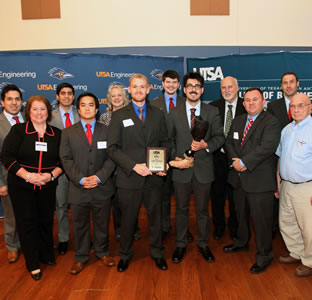Posted on May 2, 2013 by Wendy Frost

Leto Solutions team photo
UTSA competitors Cyclosa and PLaCR I.T. respectively placed second and third in the business planning competition, held Tuesday, April 30 in conjunction with the university’s first Technology Symposium at the UTSA Main Campus.
Amputees who wear prosthetic limbs frequently experience discomfort. Heat builds up in the space where their residual limb meets the prostheses, leading to the accumulation of sweat. In addition to the discomfort this causes, serious medical problems can result, such as infection, skin breakdown, ulcers and painful friction blisters.
Leto Solutions offers Aquilonix Prosthetic Cooling System, which uses thermoelectric technology integrated into a prosthetic socket worn by the patient, to regulate the temperature and reduce sweating. Leto Solutions includes undergraduate engineering majors Austin Darius, Jake Montez, David Schultz and Gary Walters and undergraduate business majors Nam Do, Eric Michael Garza, Enrique Medrano and Justin Stultz.
“It’s been six years since my leg was amputated and for six years I’ve been searching for a solution to the discomfort that I feel from heat every day wearing a prosthetic,” said Gary Walters, senior mechanical engineering major. “This competition allowed for the perfect time and opportunity to create a solution.”
During the competition, local academic, business and entrepreneurial experts judge the teams on their technology, business plan and presentation.
“This is one of the best programs in the U.S. and over the years I have seen the quality and caliber of the companies and presentations grow tremendously each year,” said Randy Goldsmith, investor-in-residence at Texas Technology Development Center and CITE competition judge. “We have had the opportunity to fund the first-place winner from four competitions ago, and we are seriously considering funding the other winners as well.”
In all, 10 student teams competed for $100,000 in cash and business-related services. The remaining teams included:
- Artemis Care developed an indoor tracking system called Apollo’s Eye that safeguards special needs individuals while respecting their freedom and privacy.
- Circa-Invention created a machine that launches Frisbees and tennis balls with a touch of a button, is designed to help children and others develop hand-eye coordination.
- Cyclosa invented a gear shifter that works on both chain and belt-driven bicycles that is lighter, quieter, stronger, more efficient and requires less maintenance than traditional shifters.
- ELD Energy Loss Detection Software detects energy leaks in a building and determines the fiscal losses caused by these leaks. It will also cost out the building improvements necessary to get rid of these problems.
- Jack N’ Slide is a wheelchair accessory that aids patients in wheelchair-to-bed transfers. Their product replaces the canvas seat of a wheelchair with a mechanical lift seat that easily bolts to the frame of a standard wheelchair.
- PLaCR I.T., provides a fast, accurate and easily repeated method of centering a gamma radiation source for small-batch Non-Destructive Testing (NDT) and inspection of pipe welds in the 36” – 60” diameter range.
- Reddo Communication System created a portable device for translating sign language into voice.
- Smart Car Seat System developed the NannyPad, a vibrating pad built into a car seat to comfort a child and detect harmful cabin temperature.
- Smart Steer, which developed a steering wheel cover that manages the infotainment system of the vehicle without requiring the driver to look away from traffic - hence decreasing distractions and unexpected accidents.
“What made this group unique is that they were so competitive with one another,” said Anita Leffel, UTSA entrepreneurship professor and associate director of CITE. “They really learned from each other and fed off each others’ energy and motivation to make their companies better and better leading up to this competition. I’m proud of all of them.”
Established in 2007 and held semi-annually, the $100K Student Technology Venture Competition at UTSA offers the largest award of all undergraduate business planning competitions in the nation. It offers UTSA’s undergraduate senior business and engineering students the opportunity to build a technology, patent it, create a business and launch it in a rigorous incubator program.
Winners receive $100,000 in cash and business-related services including consulting, marketing and legal services, office space and other benefits.
The UTSA CITE $100,000 Student Technology Venture Competition is sponsored by the Texas Research & Technology Foundation, Cox | Smith, Rackspace, the San Antonio Technology Center and Startech, and is supported by the UTSA College of Business, College of Engineering and Vice President for Research.
Wendy Frost—
Please send your comments to: wendy.frost@utsa.edu


